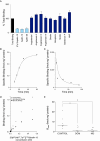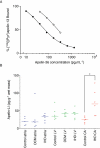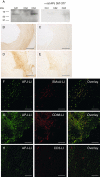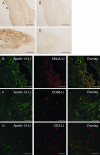Modulation of the apelin/APJ system in heart failure and atherosclerosis in man
- PMID: 20649580
- PMCID: PMC2936849
- DOI: 10.1111/j.1476-5381.2010.00821.x
Modulation of the apelin/APJ system in heart failure and atherosclerosis in man
Abstract
Background and purpose: The aim of this study was to determine whether the apelin/APJ system is altered in human cardiovascular disease by investigating whether the expression of apelin or its receptor is altered at the protein level.
Experimental approach: Radioligand binding studies were used to determine apelin receptor density in human cardiac tissues. Apelin peptide levels in cardiovascular tissues were determined by radioimmunoassay. In vitro pharmacology was used to assess vasoactive properties of apelin in human coronary artery. Localization of apelin and its receptor in coronary artery was determined using immunohistochemistry.
Key results: Apelin receptor density was significantly decreased in left ventricle from patients with dilated cardiomyopathy or ischaemic heart disease compared with controls, but apelin peptide levels remained unchanged. Apelin was up-regulated in human atherosclerotic coronary artery and this additional peptide localized to the plaque, colocalizing with markers for macrophages and smooth muscle cells. Apelin potently constricted human coronary artery.
Conclusions and implications: We have detected changes in the apelin/APJ system in human diseased cardiac and vascular tissue. The decrease in receptor density in heart failure may limit the positive inotropic actions of apelin, contributing to contractile dysfunction. The contribution of the increased apelin levels in atherosclerotic coronary artery to disease progression remains to be determined. These data suggest a potential role for the apelin/APJ system in human cardiovascular disease.
Figures





Similar articles
-
In vivo genetic profiling and cellular localization of apelin reveals a hypoxia-sensitive, endothelial-centered pathway activated in ischemic heart failure.Am J Physiol Heart Circ Physiol. 2008 Jan;294(1):H88-98. doi: 10.1152/ajpheart.00935.2007. Epub 2007 Sep 28. Am J Physiol Heart Circ Physiol. 2008. PMID: 17906101 Free PMC article.
-
Adiponectin/T-cadherin and apelin/APJ expression in human arteries and periadventitial fat: implication of local adipokine signaling in atherosclerosis?Cardiovasc Pathol. 2014 May-Jun;23(3):131-8. doi: 10.1016/j.carpath.2014.02.003. Epub 2014 Feb 25. Cardiovasc Pathol. 2014. PMID: 24675084
-
Circulating and cardiac levels of apelin, the novel ligand of the orphan receptor APJ, in patients with heart failure.Biochem Biophys Res Commun. 2003 Aug 29;308(3):480-5. doi: 10.1016/s0006-291x(03)01424-4. Biochem Biophys Res Commun. 2003. PMID: 12914775
-
Apelin and its receptor APJ in cardiovascular diseases.Clin Chim Acta. 2014 Jan 20;428:1-8. doi: 10.1016/j.cca.2013.09.001. Epub 2013 Sep 18. Clin Chim Acta. 2014. PMID: 24055369 Review.
-
The apelin-APJ system in heart failure: pathophysiologic relevance and therapeutic potential.Biochem Pharmacol. 2008 May 15;75(10):1882-92. doi: 10.1016/j.bcp.2007.12.015. Epub 2008 Jan 5. Biochem Pharmacol. 2008. PMID: 18272138 Review.
Cited by
-
Effects of Apelin on Cardiovascular Aging.Front Physiol. 2017 Dec 12;8:1035. doi: 10.3389/fphys.2017.01035. eCollection 2017. Front Physiol. 2017. PMID: 29302260 Free PMC article. Review.
-
Adipose tissue and vascular inflammation in coronary artery disease.World J Cardiol. 2014 Jul 26;6(7):539-54. doi: 10.4330/wjc.v6.i7.539. World J Cardiol. 2014. PMID: 25068015 Free PMC article. Review.
-
Competing Endogenous RNA Regulatory Networks of hsa_circ_0126672 in Pathophysiology of Coronary Heart Disease.Genes (Basel). 2023 Feb 22;14(3):550. doi: 10.3390/genes14030550. Genes (Basel). 2023. PMID: 36980823 Free PMC article.
-
Association of SNP Rs9943582 in APLNR with Left Ventricle Systolic Dysfunction in Patients with Coronary Artery Disease in a Chinese Han GeneID Population.PLoS One. 2015 May 19;10(5):e0125926. doi: 10.1371/journal.pone.0125926. eCollection 2015. PLoS One. 2015. PMID: 25993436 Free PMC article.
-
Effects of apelin on the cardiovascular system.Heart Fail Rev. 2015 Jul;20(4):505-18. doi: 10.1007/s10741-015-9475-x. Heart Fail Rev. 2015. PMID: 25652330 Review.
References
-
- Carpéné C, Dray C, Attane C, Valet P, Portillo MP, Churruca I, et al. Expanding role for the apelin/APJ system in physiopathology. J Physiol Biochem. 2007;63:359–373. - PubMed
-
- Chen MM, Ashley EA, Deng DXF, Tsalenko A, Deng A, Tabibiazar R, et al. Novel role for the potent endogenous inotrope apelin in human cardiac dysfunction. Circulation. 2003;108:1432–1439. - PubMed
-
- Chong KS, Gardner RS, Morton JJ, Ashley EA, McDonagh TA. Plasma concentrations of the novel peptide apelin are decreased in patients with chronic heart failure. Eu J Heart Fail. 2006;8:355–360. - PubMed
Publication types
MeSH terms
Substances
Grants and funding
LinkOut - more resources
Full Text Sources
Other Literature Sources
Medical
Molecular Biology Databases

